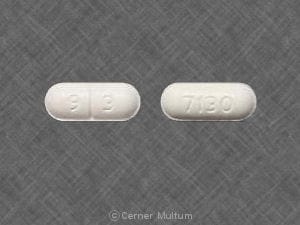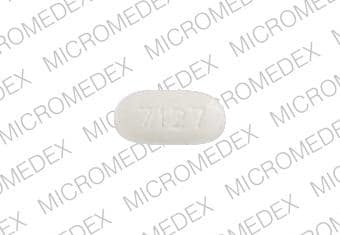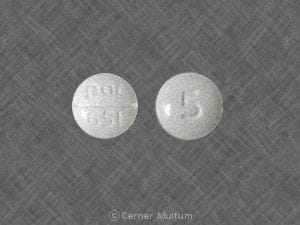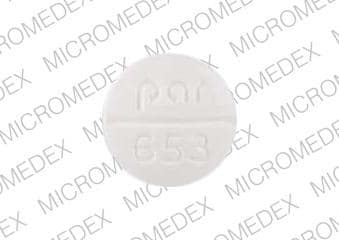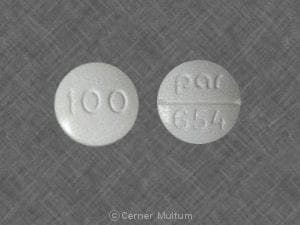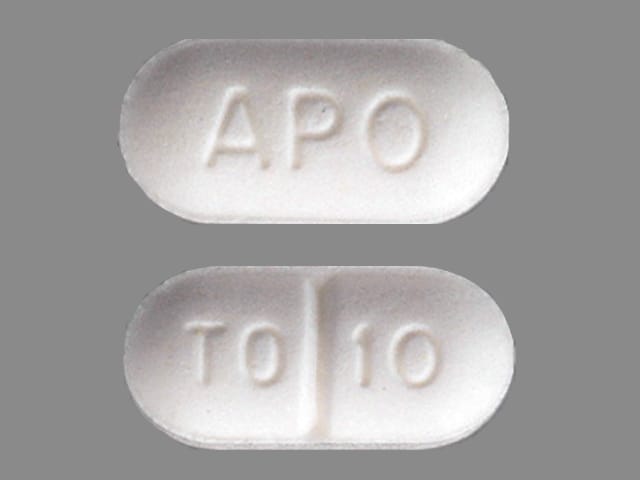Dosage Forms
Excipient information presented when available (limited, particularly for generics); consult specific product labeling. [DSC] = Discontinued product
Tablet, Oral:
Demadex: 5 mg [DSC]
Demadex: 10 mg [DSC] [scored]
Demadex: 20 mg [DSC]
Demadex: 20 mg [DSC] [scored]
Generic: 5 mg, 10 mg, 20 mg, 100 mg
Pharmacology
Mechanism of Action
Inhibits reabsorption of sodium and chloride in the ascending loop of Henle and distal renal tubule, interfering with the chloride-binding cotransport system, thus causing increased excretion of water, sodium, chloride, magnesium, and calcium; does not alter GFR, renal plasma flow, or acid-base balance
Pharmacokinetics/Pharmacodynamics
Distribution
Vd: 12 to 15 L; Cirrhosis: ~24 to 30 L.
Metabolism
Hepatic (~80%) via CYP2C9 and, to a minor extent, CYP2C8 and CYP2C18
Excretion
Urine (21%)
Onset of Action
Diuresis: Within 1 hour; Peak effect: Diuresis: 1 to 2 hours; Antihypertensive: 4 to 6 weeks (up to 12 weeks)
Time to Peak
Plasma: Within 1 hour; delayed ~30 minutes when administered with food
Duration of Action
Diuresis: ~6 to 8 hours
Half-Life Elimination
~3.5 hours
Protein Binding
Plasma: >99%
Use in Specific Populations
Special Populations: Renal Function Impairment
Renal clearance is markedly decreased in renal failure; a smaller fraction of the administered dose is delivered to the intraluminal site of action, and the natriuretic action is reduced.
Special Populations: Hepatic Function Impairment
Volume of distribution, plasma half-life, and renal clearance are increased in patients with cirrhosis.
Special Populations Note
Heart failure: Hepatic and renal clearance are decreased. Total clearance is ~50% of that seen in healthy volunteers, and the plasma half-life and AUC are correspondingly increased.
Use: Labeled Indications
Edema: Treatment of edema associated with heart failure and hepatic or renal disease.
Hypertension: Management of hypertension.
Note: Not recommended for the initial treatment of hypertension (ACC/AHA [Whelton 2017]).
Contraindications
Hypersensitivity to torsemide or any component of the formulation; anuria; hepatic coma.
Dosage and Administration
Dosing: Adult
Note: Oral dose equivalency (approximate) for patients with normal renal function (Brater 1983; Cody 1994; Vargo 1995): Torsemide 20 mg = bumetanide 1 mg = furosemide 40 mg = ethacrynic acid 50 mg
Edema:
Chronic renal failure: Oral: Initial: 20 mg once daily; may increase gradually by doubling dose until the desired diuretic response is obtained; doses >200 mg/day have not been adequately studied.
Heart failure:
Oral: Initial: 10 to 20 mg once daily; may increase gradually by doubling dose until the desired diuretic response is obtained. Maximum dose: 200 mg/day (ACCF/AHA [Yancy 2013]).
Hepatic cirrhosis: Oral: Initial: 5 to 10 mg once daily; may increase gradually by doubling dose until the desired diuretic response is obtained (maximum recommended single dose: 40 mg). Note: Administer with an aldosterone antagonist or a potassium-sparing diuretic.
Hypertension (alternative agent): Oral: Initial: 5 mg once daily; may increase to 10 mg once daily after 4 to 6 weeks if inadequate antihypertensive response (ACC/AHA [Whelton 2017]).
Dosing: Geriatric
Refer to adult dosing.
Administration
Oral: May administer with or without food.
Dietary Considerations
May cause potassium loss; potassium supplement or dietary changes may be required.
Storage
Store at 15°C to 30°C (59°F to 86°F).
Torsemide Images
Drug Interactions
Ajmaline: Sulfonamides may enhance the adverse/toxic effect of Ajmaline. Specifically, the risk for cholestasis may be increased. Monitor therapy
Alfuzosin: May enhance the hypotensive effect of Blood Pressure Lowering Agents. Monitor therapy
Allopurinol: Loop Diuretics may enhance the adverse/toxic effect of Allopurinol. Loop Diuretics may increase the serum concentration of Allopurinol. Specifically, Loop Diuretics may increase the concentration of Oxypurinol, an active metabolite of Allopurinol. Monitor therapy
Alpelisib: May decrease the serum concentration of CYP2C9 Substrates (High risk with Inducers). Monitor therapy
Amifostine: Blood Pressure Lowering Agents may enhance the hypotensive effect of Amifostine. Management: When amifostine is used at chemotherapy doses, blood pressure lowering medications should be withheld for 24 hours prior to amifostine administration. If blood pressure lowering therapy cannot be withheld, amifostine should not be administered. Consider therapy modification
Amikacin (Oral Inhalation): Loop Diuretics may enhance the nephrotoxic effect of Amikacin (Oral Inhalation). Loop Diuretics may enhance the ototoxic effect of Amikacin (Oral Inhalation). Monitor therapy
Aminoglycosides: Loop Diuretics may enhance the adverse/toxic effect of Aminoglycosides. Specifically, nephrotoxicity and ototoxicity. Monitor therapy
Amphetamines: May diminish the antihypertensive effect of Antihypertensive Agents. Monitor therapy
Angiotensin-Converting Enzyme Inhibitors: Loop Diuretics may enhance the hypotensive effect of Angiotensin-Converting Enzyme Inhibitors. Loop Diuretics may enhance the nephrotoxic effect of Angiotensin-Converting Enzyme Inhibitors. Monitor therapy
Antidiabetic Agents: Hyperglycemia-Associated Agents may diminish the therapeutic effect of Antidiabetic Agents. Monitor therapy
Antipsychotic Agents (Second Generation [Atypical]): Blood Pressure Lowering Agents may enhance the hypotensive effect of Antipsychotic Agents (Second Generation [Atypical]). Monitor therapy
Barbiturates: May enhance the hypotensive effect of Blood Pressure Lowering Agents. Monitor therapy
Benperidol: May enhance the hypotensive effect of Blood Pressure Lowering Agents. Monitor therapy
Beta2-Agonists: May enhance the hypokalemic effect of Loop Diuretics. Monitor therapy
Bilastine: Loop Diuretics may enhance the QTc-prolonging effect of Bilastine. Monitor therapy
Bile Acid Sequestrants: May decrease the absorption of Loop Diuretics. Consider therapy modification
Brigatinib: May diminish the antihypertensive effect of Antihypertensive Agents. Brigatinib may enhance the bradycardic effect of Antihypertensive Agents. Monitor therapy
Brimonidine (Topical): May enhance the hypotensive effect of Blood Pressure Lowering Agents. Monitor therapy
Bromperidol: Blood Pressure Lowering Agents may enhance the hypotensive effect of Bromperidol. Bromperidol may diminish the hypotensive effect of Blood Pressure Lowering Agents. Avoid combination
Canagliflozin: May enhance the hypotensive effect of Loop Diuretics. Management: If canagliflozin is combined with a loop diuretic, monitor for symptoms of intravascular volume depletion and hypotension. Canadian product labeling recommends avoiding the combination of canagliflozin and loop diuretics. Consider therapy modification
Cardiac Glycosides: Loop Diuretics may enhance the adverse/toxic effect of Cardiac Glycosides. Specifically, cardiac glycoside toxicity may be enhanced by the hypokalemic and hypomagnesemic effect of loop diuretics. Monitor therapy
Cefazedone: May enhance the nephrotoxic effect of Loop Diuretics. Monitor therapy
Cefotiam: Loop Diuretics may enhance the nephrotoxic effect of Cefotiam. Monitor therapy
Cefpirome: Loop Diuretics may enhance the nephrotoxic effect of Cefpirome. Monitor therapy
Ceftizoxime: Loop Diuretics may enhance the nephrotoxic effect of Ceftizoxime. Monitor therapy
Cephalothin: Loop Diuretics may enhance the nephrotoxic effect of Cephalothin. Monitor therapy
Cephradine: May enhance the nephrotoxic effect of Loop Diuretics. Monitor therapy
CISplatin: Loop Diuretics may enhance the nephrotoxic effect of CISplatin. Loop Diuretics may enhance the ototoxic effect of CISplatin. Monitor therapy
Corticosteroids (Orally Inhaled): May enhance the hypokalemic effect of Loop Diuretics. Monitor therapy
Corticosteroids (Systemic): May enhance the hypokalemic effect of Loop Diuretics. Monitor therapy
CycloSPORINE (Systemic): May enhance the adverse/toxic effect of Loop Diuretics. Monitor therapy
CYP2C9 Inducers (Moderate): May decrease the serum concentration of CYP2C9 Substrates (High risk with Inducers). Monitor therapy
CYP2C9 Inhibitors (Moderate): May increase the serum concentration of Torsemide. Monitor therapy
Dabrafenib: May decrease the serum concentration of CYP2C9 Substrates (High risk with Inducers). Management: Seek alternatives to the CYP2C9 substrate when possible. If concomitant therapy cannot be avoided, monitor clinical effects of the substrate closely (particularly therapeutic effects). Consider therapy modification
Desmopressin: Loop Diuretics may enhance the hyponatremic effect of Desmopressin. Avoid combination
Dexmethylphenidate: May diminish the therapeutic effect of Antihypertensive Agents. Monitor therapy
Diacerein: May enhance the therapeutic effect of Diuretics. Specifically, the risk for dehydration or hypokalemia may be increased. Monitor therapy
Diazoxide: May enhance the hypotensive effect of Blood Pressure Lowering Agents. Monitor therapy
Dichlorphenamide: Loop Diuretics may enhance the hypokalemic effect of Dichlorphenamide. Monitor therapy
Dofetilide: Loop Diuretics may enhance the QTc-prolonging effect of Dofetilide. Management: Monitor serum potassium and magnesium more closely when dofetilide is combined with loop diuretics. Some therapy modification may be required. Consider therapy modification
DULoxetine: Blood Pressure Lowering Agents may enhance the hypotensive effect of DULoxetine. Monitor therapy
Eltrombopag: May increase the serum concentration of OATP1B1/1B3 (SLCO1B1/1B3) Substrates. Monitor therapy
Empagliflozin: May enhance the hypotensive effect of Loop Diuretics. Monitor therapy
Enzalutamide: May decrease the serum concentration of CYP2C9 Substrates (High risk with Inducers). Management: Concurrent use of enzalutamide with CYP2C9 substrates that have a narrow therapeutic index should be avoided. Use of enzalutamide and any other CYP2C9 substrate should be performed with caution and close monitoring. Consider therapy modification
Fexinidazole [INT]: May enhance the arrhythmogenic effect of Loop Diuretics. Avoid combination
Foscarnet: Loop Diuretics may increase the serum concentration of Foscarnet. Consider therapy modification
Fosphenytoin: May diminish the diuretic effect of Loop Diuretics. Monitor therapy
Gemfibrozil: May increase the serum concentration of OATP1B1/1B3 (SLCO1B1/1B3) Substrates. See separate drug interaction monographs for agents listed as exceptions. Monitor therapy
Herbs (Hypertensive Properties): May diminish the antihypertensive effect of Antihypertensive Agents. Monitor therapy
Herbs (Hypotensive Properties): May enhance the hypotensive effect of Blood Pressure Lowering Agents. Monitor therapy
Hypotension-Associated Agents: Blood Pressure Lowering Agents may enhance the hypotensive effect of Hypotension-Associated Agents. Monitor therapy
Ipragliflozin: May enhance the adverse/toxic effect of Loop Diuretics. Specifically, the risk for intravascular volume depletion may be increased. Monitor therapy
Ivabradine: Loop Diuretics may enhance the arrhythmogenic effect of Ivabradine. Monitor therapy
Levodopa-Containing Products: Blood Pressure Lowering Agents may enhance the hypotensive effect of Levodopa-Containing Products. Monitor therapy
Levosulpiride: Loop Diuretics may enhance the adverse/toxic effect of Levosulpiride. Avoid combination
Licorice: May enhance the hypokalemic effect of Loop Diuretics. Monitor therapy
Lithium: Loop Diuretics may decrease the serum concentration of Lithium. Loop Diuretics may increase the serum concentration of Lithium. Monitor therapy
Lormetazepam: May enhance the hypotensive effect of Blood Pressure Lowering Agents. Monitor therapy
Lumacaftor and Ivacaftor: May decrease the serum concentration of CYP2C9 Substrates (High Risk with Inhibitors or Inducers). Lumacaftor and Ivacaftor may increase the serum concentration of CYP2C9 Substrates (High Risk with Inhibitors or Inducers). Monitor therapy
Mecamylamine: Sulfonamides may enhance the adverse/toxic effect of Mecamylamine. Avoid combination
Methotrexate: May diminish the therapeutic effect of Loop Diuretics. Loop Diuretics may increase the serum concentration of Methotrexate. Methotrexate may increase the serum concentration of Loop Diuretics. Management: Monitor for increased methotrexate and/or loop diuretic levels/toxicity with concomitant use of these agents and monitor for decreased therapeutic effects of loop diuretics. Methotrexate and/or loop diuretic dose reductions may be necessary. Consider therapy modification
Methylphenidate: May diminish the antihypertensive effect of Antihypertensive Agents. Monitor therapy
MiFEPRIStone: May increase the serum concentration of CYP2C9 Substrates (High risk with Inhibitors). Management: Use CYP2C9 substrates at the lowest recommended dose, and monitor closely for adverse effects, during and in the 2 weeks following mifepristone treatment. Consider therapy modification
Molsidomine: May enhance the hypotensive effect of Blood Pressure Lowering Agents. Monitor therapy
Naftopidil: May enhance the hypotensive effect of Blood Pressure Lowering Agents. Monitor therapy
Neuromuscular-Blocking Agents: Loop Diuretics may diminish the neuromuscular-blocking effect of Neuromuscular-Blocking Agents. Loop Diuretics may enhance the neuromuscular-blocking effect of Neuromuscular-Blocking Agents. Monitor therapy
Nicergoline: May enhance the hypotensive effect of Blood Pressure Lowering Agents. Monitor therapy
Nicorandil: May enhance the hypotensive effect of Blood Pressure Lowering Agents. Monitor therapy
Nitroprusside: Blood Pressure Lowering Agents may enhance the hypotensive effect of Nitroprusside. Monitor therapy
Nonsteroidal Anti-Inflammatory Agents: May diminish the diuretic effect of Loop Diuretics. Loop Diuretics may enhance the nephrotoxic effect of Nonsteroidal Anti-Inflammatory Agents. Management: Monitor for evidence of kidney injury or decreased therapeutic effects of loop diuretics with concurrent use of an NSAID. Consider avoiding concurrent use in CHF or cirrhosis. Concomitant use of bumetanide with indomethacin is not recommended. Consider therapy modification
Obinutuzumab: May enhance the hypotensive effect of Blood Pressure Lowering Agents. Management: Consider temporarily withholding blood pressure lowering medications beginning 12 hours prior to obinutuzumab infusion and continuing until 1 hour after the end of the infusion. Consider therapy modification
Opioid Agonists: May enhance the adverse/toxic effect of Diuretics. Opioid Agonists may diminish the therapeutic effect of Diuretics. Monitor therapy
Pentoxifylline: May enhance the hypotensive effect of Blood Pressure Lowering Agents. Monitor therapy
Phenytoin: May diminish the diuretic effect of Loop Diuretics. Monitor therapy
Pholcodine: Blood Pressure Lowering Agents may enhance the hypotensive effect of Pholcodine. Monitor therapy
Phosphodiesterase 5 Inhibitors: May enhance the hypotensive effect of Blood Pressure Lowering Agents. Monitor therapy
Probenecid: May enhance the adverse/toxic effect of Loop Diuretics. Probenecid may diminish the diuretic effect of Loop Diuretics. Probenecid may increase the serum concentration of Loop Diuretics. Management: Monitor for decreased diuretic effects or increased adverse effects of loop diuretics with concomitant use of probenecid. Bumetanide prescribing information recommends against concomitant use of probenecid. Monitor therapy
Promazine: Loop Diuretics may enhance the QTc-prolonging effect of Promazine. Avoid combination
Prostacyclin Analogues: May enhance the hypotensive effect of Blood Pressure Lowering Agents. Monitor therapy
Quinagolide: May enhance the hypotensive effect of Blood Pressure Lowering Agents. Monitor therapy
Reboxetine: May enhance the hypokalemic effect of Loop Diuretics. Monitor therapy
Rifapentine: May decrease the serum concentration of CYP2C9 Substrates (High risk with Inducers). Monitor therapy
RisperiDONE: Loop Diuretics may enhance the adverse/toxic effect of RisperiDONE. Monitor therapy
Salicylates: May diminish the diuretic effect of Loop Diuretics. Loop Diuretics may increase the serum concentration of Salicylates. Monitor therapy
Sodium Phosphates: Diuretics may enhance the nephrotoxic effect of Sodium Phosphates. Specifically, the risk of acute phosphate nephropathy may be enhanced. Management: Consider avoiding this combination by temporarily suspending treatment with diuretics, or seeking alternatives to oral sodium phosphate bowel preparation. If the combination cannot be avoided, hydrate adequately and monitor fluid and renal status. Consider therapy modification
Teriflunomide: May increase the serum concentration of OATP1B1/1B3 (SLCO1B1/1B3) Substrates. Monitor therapy
Tobramycin (Oral Inhalation): Loop Diuretics may enhance the nephrotoxic effect of Tobramycin (Oral Inhalation). Loop Diuretics may enhance the ototoxic effect of Tobramycin (Oral Inhalation). Monitor therapy
Tolvaptan: May increase the serum concentration of OATP1B1/1B3 (SLCO1B1/1B3) Substrates. Consider therapy modification
Topiramate: Loop Diuretics may enhance the hypokalemic effect of Topiramate. Monitor therapy
Warfarin: Torsemide may increase the serum concentration of Warfarin. Monitor therapy
Xipamide: May enhance the adverse/toxic effect of Loop Diuretics. Specifically, the risk of hypovolemia, electrolyte disturbances, and prerenal azotemia may be increased. Monitor therapy
Yohimbine: May diminish the antihypertensive effect of Antihypertensive Agents. Monitor therapy
Test Interactions
May lead to false-negative aldosterone/renin ratio (ARR) (Funder 2016)
Adverse Reactions
1% to 10%:
Cardiovascular: ECG abnormality (2%), chest pain (1%)
Central nervous system: Nervousness (1%)
Gastrointestinal: Constipation (2%), diarrhea (2%), dyspepsia (2%), nausea (2%), sore throat (2%)
Neuromuscular & skeletal: Arthralgia (2%), myalgia (2%), weakness (2%)
Renal: Polyuria (7%)
Respiratory: Rhinitis (3%), cough (2%)
<1%, postmarketing, and/or case reports: Angioedema, arthritis, atrial fibrillation, esophageal hemorrhage, gastrointestinal hemorrhage, hyperglycemia, hyperuricemia, hypokalemia, hyponatremia, hypotension, hypovolemia, impotence, increased thirst, leukopenia, pancreatitis, rectal hemorrhage, shunt thrombosis, skin rash, Stevens-Johnson syndrome, syncope, thrombocytopenia, toxic epidermal necrolysis, ventricular tachycardia, vomiting
Warnings/Precautions
Concerns related to adverse effects:
- Fluid/electrolyte loss: Loop diuretics are potent diuretics; excess amounts can lead to profound diuresis with fluid and electrolyte loss; close medical supervision and dose evaluation are required. In contrast to thiazide diuretics, a loop diuretic can also lower serum calcium concentrations. Electrolyte disturbances can predispose a patient to serious cardiac arrhythmias. Monitor for electrolyte disturbances (eg, hypokalemia, hyponatremia, hypomagnesemia, hypocalcemia, hypochloremic alkalosis) periodically.
- Hyperuricemia: Asymptomatic hyperuricemia may occur; gout may be precipitated (rarely).
- Nephrotoxicity: Monitor fluid status and renal function in an attempt to prevent oliguria, azotemia, and reversible increases in BUN and creatinine; close medical supervision of aggressive diuresis required.
- Ototoxicity: Tinnitus and hearing loss (usually reversible) have been observed; risk may be increased in patients with severe renal impairment, excessive doses, hypoproteinemia, and concurrent use of other ototoxins (eg, aminoglycosides).
- Sulfonamide (“sulfa”) allergy: The FDA-approved product labeling for many medications containing a sulfonamide chemical group includes a broad contraindication in patients with a prior allergic reaction to sulfonamides. There is a potential for cross-reactivity between members of a specific class (eg, two antibiotic sulfonamides). However, concerns for cross-reactivity have previously extended to all compounds containing the sulfonamide structure (SO2NH2). An expanded understanding of allergic mechanisms indicates cross-reactivity between antibiotic sulfonamides and nonantibiotic sulfonamides may not occur or at the very least this potential is extremely low (Brackett 2004; Johnson 2005; Slatore 2004; Tornero 2004). In particular, mechanisms of cross-reaction due to antibody production (anaphylaxis) are unlikely to occur with nonantibiotic sulfonamides. T-cell-mediated (type IV) reactions (eg, maculopapular rash) are less well understood and it is not possible to completely exclude this potential based on current insights. In cases where prior reactions were severe (Stevens-Johnson syndrome/TEN), some clinicians choose to avoid exposure to these classes.
Disease-related concerns:
- Adrenal insufficiency: Avoid use of diuretics for treatment of elevated blood pressure in patients with primary adrenal insufficiency (Addison disease). Adjustment of glucocorticoid/mineralocorticoid therapy and/or use of other antihypertensive agents is preferred to treat hypertension (Bornstein 2016; Inder 2015).
- Bariatric surgery: Dehydration: Avoid diuretics in the immediate postoperative period after bariatric surgery; electrolyte disturbances and dehydration may occur. Diuretics may be resumed, if indicated, once oral fluid intake goals are met (Ziegler 2009).
- Diabetes: Use with caution in patients with diabetes; increased blood glucose levels and hyperglycemia may occur. Monitor blood glucose periodically.
- Hepatic impairment: Use with caution in patients with hepatic impairment; in patients with cirrhosis, avoid electrolyte and acid/base imbalances that may lead to hepatic encephalopathy. Administration with an aldosterone antagonist or potassium-sparing diuretic may provide additional diuretic efficacy and maintain normokalemia in patients with hepatic disease.
Concurrent drug therapy issues:
- Drug-drug interactions: Potentially significant interactions may exist, requiring dose or frequency adjustment, additional monitoring, and/or selection of alternative therapy. Consult drug interactions database for more detailed information.
Special populations:
- Surgical patients: If given the morning of surgery, torsemide may render the patient volume depleted and blood pressure may be labile during general anesthesia.
Other warnings and precautions:
- Diuretic resistance: For some patients, despite higher doses of loop diuretic treatment, an adequate diuretic response cannot be attained. Diuretic resistance can usually be overcome by intravenous administration, the use of two diuretics together (eg, furosemide and chlorothiazide), or the use of a diuretic with a positive inotropic agent. When such combinations are used, serum electrolytes need to be monitored even more closely (Cody 1994, ACC/AHA [Yancy 2013]; HFSA 2010).
Monitoring Parameters
Periodically monitor renal function, serum electrolytes, serum glucose, volume status, blood pressure, and diuretic effect.
Pregnancy
Pregnancy Considerations
Adverse events have been observed in animal reproduction studies.
Patient Education
What is this drug used for?
- It is used to get rid of extra fluid. It is used to treat high blood pressure.
Other side effects of this drug: Talk with your doctor right away if you have any of these signs of:
- Fluid and electrolyte problems like mood changes, confusion, muscle pain or weakness, abnormal heartbeat, very bad dizziness or passing out, fast heartbeat, more thirst, seizures, feeling very tired or weak, not hungry, unable to pass urine or change in the amount of urine produced, dry mouth, dry eyes, or nausea or vomiting
- High blood sugar like confusion, feeling sleepy, more thirst, hunger, passing urine more often, flushing, fast breathing, or breath that smells like fruit
- Kidney problems like unable to pass urine, blood in the urine, change in amount of urine passed, or weight gain
- Severe dizziness
- Passing out
- Trouble hearing
- Noise or ringing in the ears
- Signs of a significant reaction like wheezing; chest tightness; fever; itching; bad cough; blue skin color; seizures; or swelling of face, lips, tongue, or throat.
Note: This is not a comprehensive list of all side effects. Talk to your doctor if you have questions.
Consumer Information Use and Disclaimer: This information should not be used to decide whether or not to take this medicine or any other medicine. Only the healthcare provider has the knowledge and training to decide which medicines are right for a specific patient. This information does not endorse any medicine as safe, effective, or approved for treating any patient or health condition. This is only a brief summary of general information about this medicine. It does NOT include all information about the possible uses, directions, warnings, precautions, interactions, adverse effects, or risks that may apply to this medicine. This information is not specific medical advice and does not replace information you receive from the healthcare provider. You must talk with the healthcare provider for complete information about the risks and benefits of using this medicine.
